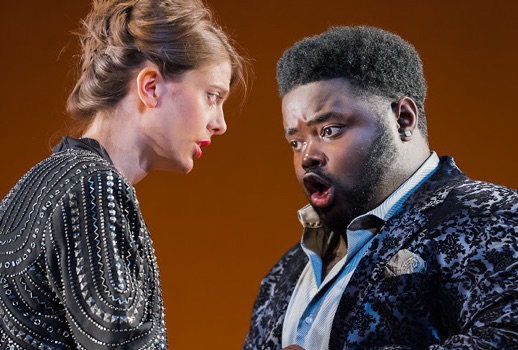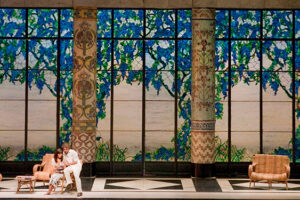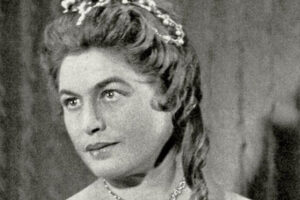

Despite the wild popularity of his concerti and choral music, Vivaldi’s operas have been much slower to gain the public’s attention. Erato’s recording of Orlando Furioso with Marilyn Horne and Victoria de los Angeles made around the time of the tricentenary of the composer’s birth was probably the first chance many had to hear one. But the explosion of interest in opera seria since then has brought nearly all of Vivaldi’s surviving operas to concert halls, CD players and opera houses with increasing frequency. A production of Catone at this past summer’s Glimmerglass Festival (less than an hour from New York’s own Utica) by Tazewell Thompson conducted by Opera Lafayette’s Artistic Director Ryan Brown served as the impetus for last weekend’s performances in DC and Tuesday’s in New York.
Many of Vivaldi’s over 50 operas have been lost so we can only imagine what Tieteberga or Scanderbeg were like, and only the second and third acts of Catone have survived. The recent excellent Näive CD includes a canny, convincing reconstruction by Alessandro Ciccolini of Catone’s missing first act. However, Brown decided to perform only the two Vivaldi acts which thrust us in medias res into the bitter struggle for power over Rome between Catone and Cesare that is at the center of one of Metastasio’s most popular libretti.
Its first setting by Leonardo Vinci in 1728 shocked many as it eschewed the expected lieto fine and ended with Catone’s on-stage suicide. Vivaldi, who set only one other Metastasio text (L’Olimpiade), would have none of that sort of thing and his 1737 version proposes an unconvincing last-minute change of heart by Catone followed by a perfunctory “happy ending” chorus. Giovanni Batista Ferrandini who composed a Catone for the 1753 opening of Munich’s Cuvilliéstheater ended his with an allegorical instrumental ballo (now lost), while Piccinni’s 1770 version concludes with a stark accompagnato.
While one might question why Opera Lafayette (and Glimmerglass) mounted a partial torso rather than one of the composer’s surviving complete works, Catone does contain some of Vivaldi’s most striking, challenging music which Tuesday’s cast tackled with relish and a good deal of success.
Dominating was the impressive Cesare of African-American countertenor John Holiday who has made enormous strides since his promising Radamisto at Juilliard just two years ago. His singing then could be shyly introverted while his stage presence was green in the extreme. But as the Roman conqueror he commanded the stage with vigor and confidence, and his strong mezzo soared easily to a startlingly pungent soprano range which he exploited in the showy “Se in campo armato.” However, his finest moment was his first; in “Se mai senti spirarti,” one of Vivaldi’s most ravishing creations, Holiday beautifully spun out the aria’s long, languishing lines with gently glowing tone.
His fellow countertenor Eric Jurenas had just one aria as Fulvio, but his round, mellow voice made it count. He vividly demanded vengeance in “Degl’Elisi dal soggiorno” which features an intriguing B section in which he thinks twice about his bloodthirsty plans. Jurenas made the most of this abrupt contrast and decorated the da capo repeat with such extravagantly dazzling coloratura flourishes that it became the vocal high point of the evening. Mezzo Marguerite Krull in trousers and pigtails as Arbace dispatched her aria with easy agility but sometimes arid tone and a scratchy top.
Anna Reinhold, who four years ago stole the show as Cybèle when Lully’s Atys returned to the Brooklyn Academy of Music, took on the part of Catone’s beleaguered daughter. Her lean mezzo seized the dramatic opportunities in Marzia’s tortured, declamatory arias but one sometimes wanted a weightier voice in music written for Vivaldi’s favorite singer (and probable mistress), the contralto Anna Girò.
Icy blonde mezzo Julia Dawson in emerald sequins fought heroically with the near-impossible demands of Emilia, Pompeo’s widow who skulked and snarled in the shadows while plotting to avenge her husband’s murder. Her two arias may be the most fiendishly difficult that Vivaldi ever wrote and Dawson brought an over-the-top flair and stinging top notes to the powerfully florid “Come invano il mare irato” which ends the second act.
The even more challenging “Nella foresta” with its braying horns was less successful, but one admired her all-out ferocity.
Tenor Thomas Michael Allen, whom I last saw in 2004 shimmying across the stage of the Théâtre des Champs-Elysées as a startlingly vain Arnalta in L’Incoronazione di Poppea, embodied the proud, obstinate Catone. His part doesn’t present the vocal challenges offered the others but he dominated the action with his forceful declamation of the all-important recitatives. In fact, the entire cast had clearly worked very hard to make arresting the many extensive recitatives, and they received heroic support from the continuo group of cellist Loretta O’Sullivan, harpsichordist Andrew Appel and Michael Leopold on a pair of plucked instruments. The inclusion of this trio’s biographies in the program was unprecedented in my experience and well deserved.
Thompson’s spare and elegant production, adapted from his work at Glimmerglass, set forth the complicated drama with clarity on a stage which featured only a silver throne and the remnants of the capitals of two ruined Roman columns. Happily he avoided the all-too-common sin of devising bits of distracting business for the long da capo arias. Amith Chandrashaker’s stark yet apt lighting also contributed to the evening’s simple yet effective dramatic punch.
While Brown’s band may have lacked the insouciant dynamism embraced by several Italian early music groups who specialize in Vivaldi, it played with welcome warmth and flair. Tempi were often swift and exciting yet didn’t push the singers beyond their capabilities. The ornaments embraced by Jurenas and Dawson were the most dangerously bracing, but the rest also decorated with panache.
Although I have heard Vivaldi operas in concert, this was my first one staged. In fact, has there ever been a Vivaldi opera staged in New York before this Catone? With economy, taste and talented, committed singers, Opera Lafayette ably demonstrated that the Red Priest’s works can be theatrically viable and its Catone made me eager for more.
Photo: Louis Forget
























Comments